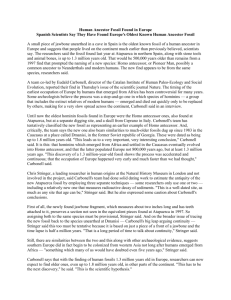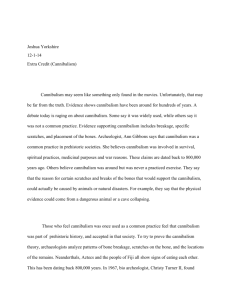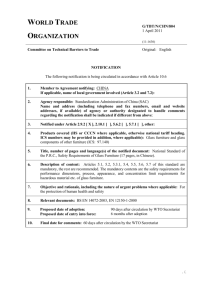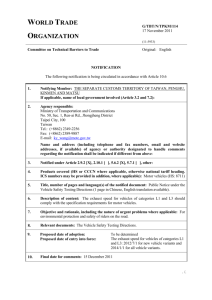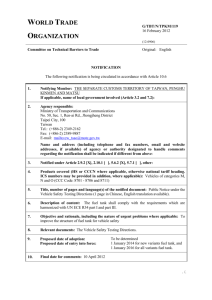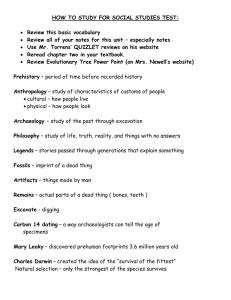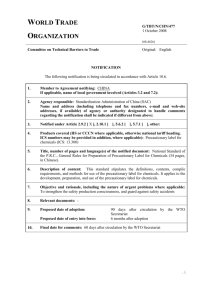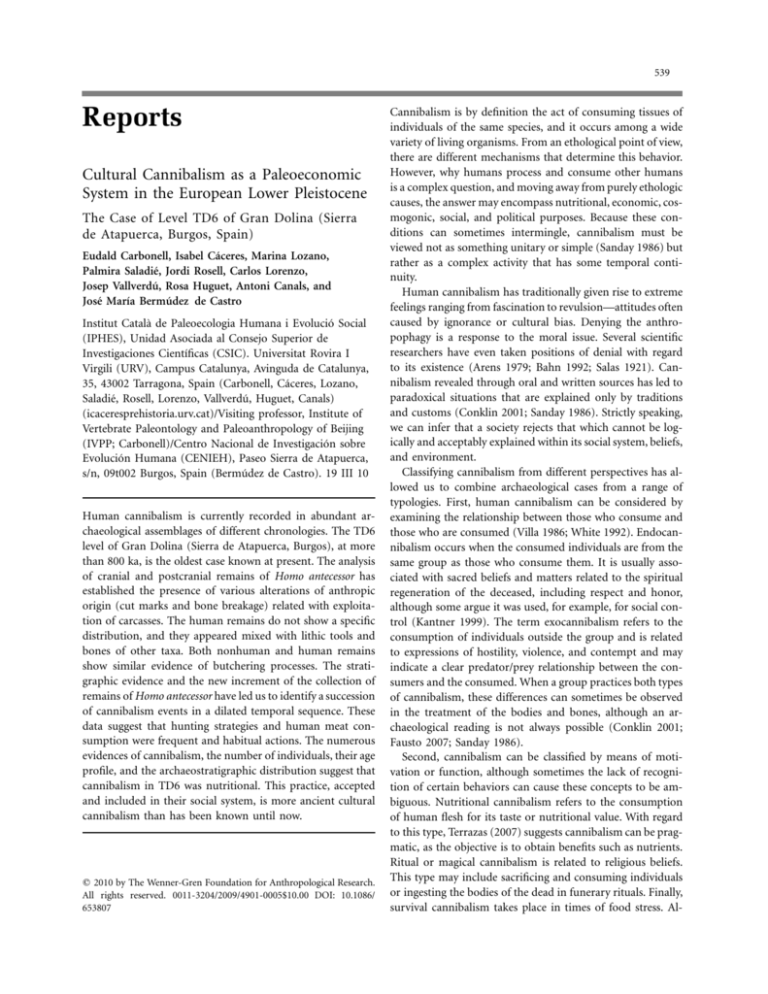
539
Reports
Cultural Cannibalism as a Paleoeconomic
System in the European Lower Pleistocene
The Case of Level TD6 of Gran Dolina (Sierra
de Atapuerca, Burgos, Spain)
Eudald Carbonell, Isabel Cáceres, Marina Lozano,
Palmira Saladié, Jordi Rosell, Carlos Lorenzo,
Josep Vallverdú, Rosa Huguet, Antoni Canals, and
José Marı́a Bermúdez de Castro
Institut Català de Paleoecologia Humana i Evolució Social
(IPHES), Unidad Asociada al Consejo Superior de
Investigaciones Cientı́ficas (CSIC). Universitat Rovira I
Virgili (URV), Campus Catalunya, Avinguda de Catalunya,
35, 43002 Tarragona, Spain (Carbonell, Cáceres, Lozano,
Saladié, Rosell, Lorenzo, Vallverdú, Huguet, Canals)
(icaceresprehistoria.urv.cat)/Visiting professor, Institute of
Vertebrate Paleontology and Paleoanthropology of Beijing
(IVPP; Carbonell)/Centro Nacional de Investigación sobre
Evolución Humana (CENIEH), Paseo Sierra de Atapuerca,
s/n, 09t002 Burgos, Spain (Bermúdez de Castro). 19 III 10
Human cannibalism is currently recorded in abundant archaeological assemblages of different chronologies. The TD6
level of Gran Dolina (Sierra de Atapuerca, Burgos), at more
than 800 ka, is the oldest case known at present. The analysis
of cranial and postcranial remains of Homo antecessor has
established the presence of various alterations of anthropic
origin (cut marks and bone breakage) related with exploitation of carcasses. The human remains do not show a specific
distribution, and they appeared mixed with lithic tools and
bones of other taxa. Both nonhuman and human remains
show similar evidence of butchering processes. The stratigraphic evidence and the new increment of the collection of
remains of Homo antecessor have led us to identify a succession
of cannibalism events in a dilated temporal sequence. These
data suggest that hunting strategies and human meat consumption were frequent and habitual actions. The numerous
evidences of cannibalism, the number of individuals, their age
profile, and the archaeostratigraphic distribution suggest that
cannibalism in TD6 was nutritional. This practice, accepted
and included in their social system, is more ancient cultural
cannibalism than has been known until now.
䉷 2010 by The Wenner-Gren Foundation for Anthropological Research.
All rights reserved. 0011-3204/2009/4901-0005$10.00 DOI: 10.1086/
653807
Cannibalism is by definition the act of consuming tissues of
individuals of the same species, and it occurs among a wide
variety of living organisms. From an ethological point of view,
there are different mechanisms that determine this behavior.
However, why humans process and consume other humans
is a complex question, and moving away from purely ethologic
causes, the answer may encompass nutritional, economic, cosmogonic, social, and political purposes. Because these conditions can sometimes intermingle, cannibalism must be
viewed not as something unitary or simple (Sanday 1986) but
rather as a complex activity that has some temporal continuity.
Human cannibalism has traditionally given rise to extreme
feelings ranging from fascination to revulsion—attitudes often
caused by ignorance or cultural bias. Denying the anthropophagy is a response to the moral issue. Several scientific
researchers have even taken positions of denial with regard
to its existence (Arens 1979; Bahn 1992; Salas 1921). Cannibalism revealed through oral and written sources has led to
paradoxical situations that are explained only by traditions
and customs (Conklin 2001; Sanday 1986). Strictly speaking,
we can infer that a society rejects that which cannot be logically and acceptably explained within its social system, beliefs,
and environment.
Classifying cannibalism from different perspectives has allowed us to combine archaeological cases from a range of
typologies. First, human cannibalism can be considered by
examining the relationship between those who consume and
those who are consumed (Villa 1986; White 1992). Endocannibalism occurs when the consumed individuals are from the
same group as those who consume them. It is usually associated with sacred beliefs and matters related to the spiritual
regeneration of the deceased, including respect and honor,
although some argue it was used, for example, for social control (Kantner 1999). The term exocannibalism refers to the
consumption of individuals outside the group and is related
to expressions of hostility, violence, and contempt and may
indicate a clear predator/prey relationship between the consumers and the consumed. When a group practices both types
of cannibalism, these differences can sometimes be observed
in the treatment of the bodies and bones, although an archaeological reading is not always possible (Conklin 2001;
Fausto 2007; Sanday 1986).
Second, cannibalism can be classified by means of motivation or function, although sometimes the lack of recognition of certain behaviors can cause these concepts to be ambiguous. Nutritional cannibalism refers to the consumption
of human flesh for its taste or nutritional value. With regard
to this type, Terrazas (2007) suggests cannibalism can be pragmatic, as the objective is to obtain benefits such as nutrients.
Ritual or magical cannibalism is related to religious beliefs.
This type may include sacrificing and consuming individuals
or ingesting the bodies of the dead in funerary rituals. Finally,
survival cannibalism takes place in times of food stress. Al-
540
Current Anthropology Volume 51, Number 4, August 2010
Figure 1. Schematic plan of the TD6 level from south to north. The test
pit (south area) was excavated in 1994–1995, whereas the excavations of
the middle and north areas are in progress (2003–2010). A color version
of this figure is available in the online edition.
though these are the most widely accepted and processed types
of cannibalism found in archaeological sites, there are still
other possible motivations for human cannibalism, such as
using it for medicinal or figurative purposes.
Regardless of how cannibalism is viewed from the outside,
it is usually closely linked to the cultural systems of the groups
that practice it. The term culture comprises the ways of life,
traditions, and beliefs that make up a social system. Cannibalism within any of these areas becomes a cultural phenomenon. The motivations that lead humans to consume conspecifics are diverse, and the complexity escalates as societies
become increasingly structured and hierarchical. It is precisely
with regard to such groups that cultural cannibalism has been
defined: a practice seen as part of the system of values and
beliefs within a society, usually associated with a symbolic
component (Fausto 2007; Sanday 1986). Archaeological remains cannot always provide answers to these questions because there may be expressions in the practice of anthropic
cannibalism that are archaeologically unrecognizable.
The archaeological record leaves no doubt about the existence of such practices among different species within the
genus Homo, from the Pleistocene until recent prehistory in
Europe, starting with Homo antecessor (Fernández-Jalvo et al.
1996, 1999) and including Neanderthals (Defleur et al. 1999;
Rosas et al. 2006) and Homo sapiens during the Upper Paleolithic (Andrews and Fernández-Jalvo 2003) and the Mesolithic (Boulestin 1999). In the Neolithic, evidence of cannibalism at archaeological sites increases quantitatively (Botella
and Alemán 1998; Botella, Alemán, and Jiménez 2000; Villa
et al. 1986a, 1986b). Finally, such practices have recently been
documented in Bronze Age sites on the Iberian Peninsula
(Cáceres, Lozano, and Saladié 2007).
Cannibalism is identified in archaeological contexts
through taphonomic criteria (Cáceres, Lozano, and Saladié
2007; Turner and Turner 1992; Villa et al. 1986b; White 1992).
The oldest example of this behavior currently comes from the
remains recovered from level TD6 of the Gran Dolina site at
the Sierra de Atapuerca (Spain; Fernández-Jalvo et al. 1996,
1999). The remains found there during the first phase of
interventions provide clear evidence of nutritional cannibalism (Fernández-Jalvo et al. 1996, 1999). This kind of cannibalism gives rise to two different assumptions: (1) it was a
repetitive behavior over time as part of a culinary tradition;
versus (2), it occurred in response to a time of nutritional
stress, as a specific case of survival cannibalism. Stratigraphic
data along with the taphonomic and zooarchaeological results
presented in this paper suggest that the evidence of canni-
Figure 2. North-south schema at Gran Dolina lithostratigraphic unit 6
(top right); southern Trinchera stratigraphic unit 6 and bedsets (Ssp; left).
Left center, microstratigraphy of Gran Dolina bedset 6.2, located in the
northern face of the sounding pit. Cave morphology reconstruction: 1 p
hypothetical cave morphology; 2 p observed cave morphology. A, Gran
Dolina 6.2 bedset; B, microstratigraphical units; C, facies number; D,
facies description; E, sedimentary process and deposits. Limits: 1 p
abrupt and flat, 2 p scoured surface, 3 p gradual and flat. Sedimentary
structures and lithologies: 4 p sand and mud, 5 p mud, 6 p granules
and fine gravels matrix to clast supported, 7 p sand and clay, 8 p
lithoclast and speleothems, 9 p massive, 10 p lamina set, 11 p grading
and partial alineation, 12 p calcareous coarse gravels and blocks, 13 p
current marks and paleocurrent orientation, 14 p human remains. Pedological structures: 15 p prismatic, subangular, and granular microaggregation; 16 p dusty coatings, coarse infillings, and intercalation textural features; 17 p desiccation figures and fissural textural infillings.
542
Current Anthropology Volume 51, Number 4, August 2010
Table 1. Number of identified specimens (NISP) and taxa of level TD6
Taxa
Homo antecessor
Eucladoceros giulii
Cervus elaphus
D. nestii? vallonetensis
Cervidae indet. medium size
Cervidae indet. small size
Cervidae indet.
cf. Bison voigtstedtenensis
Equus stenonian
Stephanorhinus etruscus
Sus scrofa
Cercopithecidae
Mammuthus sp.
Canis mosbachensis
Vulpes praeglacialis
Canidae indet.
Ursus dolinensis
Crocuta crocuta
Lynx sp.
Carnivora
Total
NISP
165
32
8
18
283
91
159
119
59
45
1
2
1
17
7
1
9
3
4
15
1,039
Note. indet. p indeterminate.
balism found in level TD6 may be the result of the first
scenario.
Level TD6 of Gran Dolina
The Sierra de Atapuerca is located 14 km east of the city of
Burgos, Spain, and has a maximum altitude of 1,082 m above
sea level. There are several Pleistocene deposits found in this
area, one of which is Gran Dolina. The Gran Dolina cavity
is made up of 11 lithostratigraphic units, all with archaeopaleontological records except for TD1, TD2, and TD3, which
are sterile. The lower levels of this site (TDW4, TDW5, TD5,
and TD6) have provided evidence (lithic tools and faunal
remains) of settlement close to a million years ago.
Two phases of excavation of level TD6 of Gran Dolina have
been carried out to date. The first is a biostratigraphic test
pit (9 m2) dug between 1993 and 1997, and the second is a
profiled section of the site with the Railway Trench (13 m2;
fig. 1). In 1994 the biostratigraphic test pit reached the upper
part of level TD6. An unprecedented set of human remains
was recovered in this level, showing clear anthropogenic signs
of processing associated with a significant accumulation of
lithic tools and faunal remains. Different methods of dating
and biostratigraphic studies have established that level TD6
of Gran Dolina was formed during the end of the Lower
Pleistocene (Berger et al. 2008; Falguères et al. 1999; Parés
and Pérez-González 1995, 1999; Pérez-González et al. 2001).
Paleoanthropological studies indicate that the human remains
belong to a new species. Using the ATD6–5 jaw and the teeth
as holotypes, the remains were classified as Homo antecessor
(Bermúdez de Castro et al. 1997). Due to the importance of
the assemblage, the layer was named the Aurora Stratum (Carbonell et al. 1999a).
The Aurora Stratum was excavated between 1994 and 1995.
Archaeoestratigraphic and sedimentological studies indicated
the existence of different microstratigraphic units arranged
on a northwest-southeast slope (fig. 2). This phenomenon
suggests some diachrony in the formation of the complex.
However, the diachrony was difficult to quantify because the
vertical resolution of archaeostratigraphic unit 1 is low (Canals, Vallverdú, and Carbonell 2003). The excavation works
in level TD6 have been underway since 2003. New human
remains, macromammal fossils, and lithic tools have been
recovered in this sector, indicating that these associations of
elements are distributed throughout the surface of the site
(Bermúdez de Castro et al. 2008). Sediment mainly originates
from a gravitational entrance located to the north of Gran
Dolina and forms a smooth northwest-southeast slope. At
approximately squares 15–16, these deposits interdigitate with
those identified in the test pit, and a change of slope occurs.
The magnetic north stratigraphic profile of the level TD6
test pit shows a bed set at least four lithofacies rhythms within
archaeostratigraphic unit 1 (Canals, Vallverdú, and Carbonell
2003; Vallverdú et al. 2001). The microstratigraphic units are
made up of a rhythm of muds and calcarenites with granules
of limestone. This allowed many of the objects recovered
during this excavation phase to be assigned to their respective
lithofacies rhythms or equivalent surfaces. The excavation of
this area has revealed the existence of human remains in each
of these well-stratified sedimentary rhythms and, consequently, the existence of multiple processing events of human
carcasses in Gran Dolina during the formation process of level
TD6.
In level TD6, together with the human fossils we have
recovered fossils of other animals and 845 lithic artifacts made
from flint (Neogene and Cretaceous), quartzite, sandstone,
quartz, and limestone. The diversity of raw materials was the
result of selection behavior because the retouched pieces have
been preferentially made with Cretaceous flint (Carbonell et
al. 1999b). Macromammal species are abundant and 15 different taxa have been identified (tables 1, 2): H. antecessor,
Ursus dolinensis, Canis mosbachensis, Vulpes praeglacialis, Crocuta crocuta, Lynx sp., Mustela palerminea, Mammuthus sp.,
Equus cf. altidens, Stephanorhinus etruscus, Cervus elaphus,
Eucladoceros giulii, Dama nestii vallonetensis, cf. “Bison voigtstedtensis,” and Sus scrofa (Bermúdez de Castro et al. 1997;
Garcı́a 2001; Garcı́a and Arsuaga 1999; van der Made 1998,
1999). Both lithic tools and faunal remains allow us to infer
that the TD6 level represents a camp site (Carbonell et al.
1999b; Dı́ez et al. 1999). The tool manufacturing process took
place inside the cave because all the structural categories produced during the successive stages of the chaı̊nes opératoires
are represented. We have recovered cores and flakes derived
from reduction sequences and from retouching artifacts. Also
we have found two sets of refitted artifacts of Neogene flint,
suggesting that their flaking occurred inside the cave. In re-
543
Table 2. Number of identified specimens (NISP) and minimal number of elements (MNE) grouped for size-weight category and Homo antecessor remains
NISP (MNE)
Antler/corn
Skull
Maxillae
Mandible
Maxillae/mandible
Isolated tooth
Hiodes
Vertebrae
Clavicle
Ribs
Coxae
Scapula
Humerus
Radius
Ulna
Carpals
Femur
Patella
Tibia
Fibula
Talus
Calcaneus
Tarsals
Metapodial
Phalanges
Long bone
Flat bone
Articular bone
Indeterminates
Total
Very large
(+1,000 kg)
Large
(300–1,000 kg)
⫺ (⫺)
2 (2)
⫺(1)
6 (2)
⫺ (⫺)
13 (⫺)
⫺ (⫺)
2 (2)
⫺ (⫺)
4 (1)
1 (1)
⫺ (⫺)
1 (1)
⫺ (⫺)
2 (1)
1 (1)
1 (1)
⫺ (⫺)
⫺ (⫺)
⫺ (⫺)
⫺ (⫺)
⫺ (⫺)
1 (1)
⫺ (⫺)
1 (1)
1 (⫺)
4 (⫺)
2 (⫺)
1 (⫺)
4
20
3
8
1
71
1
17
⫺
72
2
4
12
19
6
9
15
⫺
31
⫺
2
2
1
44
15
181
118
14
58
43 (15)
730 (98)
(⫺)
(2)
(6)
(6)
(⫺)
(⫺)
(1)
(7)
(⫺)
(11)
(1)
(2)
(6)
(4)
(1)
(9)
(4)
(⫺)
(11)
(⫺)
(2)
(2)
(1)
(12)
(10)
(⫺)
(⫺)
(⫺)
(⫺)
Medium
(100–300 kg)
55
58
4
11
2
52
⫺
49
⫺
89
7
6
34
26
8
1
30
⫺
26
2
2
⫺
4
42
13
461
198
10
3
(⫺)
(5)
(3)
(7)
(⫺)
(⫺)
(⫺)
(7)
(⫺)
(8)
(1)
(2)
(7)
(7)
(3)
(1)
(5)
(⫺)
(7)
(2)
(2)
(⫺)
(4)
(12)
(13)
(⫺)
(⫺)
(⫺)
(⫺)
1,193 (96)
Small
(!100 kg)
2
62
⫺
10
⫺
15
1
63
⫺
129
5
9
9
14
4
6
25
2
10
⫺
2
⫺
3
27
19
186
95
10
5
(⫺)
(5)
(⫺)
(2)
(⫺)
(⫺)
(1)
(11)
(⫺)
(18)
(5)
(6)
(2)
(7)
(4)
(6)
(12)
(2)
(6)
(⫺)
(2)
(⫺)
(3)
(10)
(17)
(⫺)
(⫺)
(⫺)
(⫺)
713 (119)
Homo antecessor
(!100 kg)
⫺
21
4
5
⫺
24
⫺
19
3
31
2
3
3
2
2
5
4
2
2
2
⫺
1
⫺
6
24
⫺
⫺
⫺
⫺
(⫺)
(3)
(5)
(5)
(⫺)
(⫺)
(⫺)
(14)
(⫺)
(14)
(1)
(3)
(3)
(2)
(2)
(5)
(2)
(2)
(2)
(2)
(⫺)
(1)
(⫺)
(5)
(18)
(⫺)
(⫺)
(⫺)
(⫺)
165 (92)
Indeterminate
160
12
⫺
1
⫺
31
⫺
9
1
16
1
1
⫺
⫺
⫺
⫺
⫺
⫺
⫺
⫺
⫺
⫺
⫺
3
⫺
9
9
3
1,312
(⫺)
(⫺)
(⫺)
(⫺)
(⫺)
(⫺)
(⫺)
(⫺)
(⫺)
(⫺)
(⫺)
(⫺)
(⫺)
(⫺)
(⫺)
(⫺)
(⫺)
(⫺)
(⫺)
(⫺)
(⫺)
(⫺)
(⫺)
(⫺)
(⫺)
(⫺)
(⫺)
(⫺)
(⫺)
1,567 (⫺)
Total
221
175
11
41
3
206
2
159
3
341
18
23
59
61
22
22
75
4
69
4
6
3
9
122
72
838
424
39
1,379
(⫺)
(16)
(15)
(22)
(⫺)
(⫺)
(2)
(41)
(3)
(52)
(9)
(13)
(19)
(20)
(11)
(22)
(24)
(4)
(26)
(4)
(6)
(3)
(9)
(39)
(59)
(⫺)
(⫺)
(⫺)
(⫺)
4,411 (419)
Sources. Data from Huguet 2007; Saladié 2009.
lation with the faunal remains, there is evidence of all the
butchering process stages, and so we infer a primary or early
access to carcasses that were obtained by either hunting or
scavenging (Dı́ez et al. 1999).
One of the most outstanding features of H. antecessor is
the primitive morphology of its teeth. This morphology is
similar to that of hominids from Africa 1.8 and 1.4 million
years ago (Bermúdez de Castro et al. 1999, 2001). These hominids also share many of their dental characteristics with Asian
Homo erectus and other African forms at periods a little more
recent than that determined in TD6. The facial morphology
of individual 3 is similar to that of current human populations, while the frontal bone retains a primitive morphology
(Arsuaga et al. 1999). Other features present in the fossils of
Dolina, such as the high squama temporalis and the presence
of the styloid process, are shared with Neanderthals and Homo
sapiens and, therefore, bring together the three populations
in the same clade. The absence of derived features and the
set of cranial and dental features have led us to propose H.
antecessor as the last common ancestor between the African
lineage that gave rise to our species, H. sapiens, and the lineage
leading to the European Neanderthals of the Upper Pleistocene (Arsuaga et al. 1999; Bermúdez de Castro et al. 1997).
To date 165 remains have been recovered that correspond
to a minimum of 11 individuals of different ages. Specifically,
six individuals have been identified as children, four of which
are 0–4 years old and two of which are between 5 and 9 years
old; two adolescents 10–14 years old; and three young adult
individuals 15–20 years old (Bermúdez de Castro et al. 2006,
2008, 2010). Although the assignment of sex is very problematic with incomplete remains, the size of the mandibular body
enabled us to identify two male individuals (hominids 1 and
10) and a female individual (hominid 7; Bermúdez de Castro
et al. 2008; Carbonell et al. 2005). Human remains recovered
include teeth and cranial and postcranial elements. The majority of human remains are very fragmented. In fact, there
are no complete cranial elements, and axial wholes are scarce.
Evidence of Cultural Cannibalism in TD6
The analysis of the cranial and postcranial remains of Homo
antecessor has established the presence of several damages of
Figure 3. Examples of human damage on human remains of TD6 of
Gran Dolina. Top left, humerus of an infantile specimen without evident
human modifications; top right, maxilla that shows a percussion pit on
the zygomatic process; bottom left, cut marks on the shaft fragment of
tibia—these incisions are related to defleshing of the corpse; bottom right,
human rib with incisions on the ventral side of angle.
545
Table 3. Homo antecessor remains with human-induced modifications
Cut
marks
NISP
Percussion
pits
%h
Skull
Mandible
Vertebrae
Ribs
Clavicle
Scapula
Radius
Ulna
Coxae
Femur
Fibula
Tibia
Metapodial
Phalange
7
2
3
12
4
1
2
2
1
4
1
2
3
4
4.2
1.2
1.8
7.2
2.4
.6
1.2
1.2
.6
2.4
.6
1.2
1.8
2.4
Total
48
28.7
NISP
%h
4
1
..
1
..
..
..
1
..
2
..
..
..
1
2.4
.6
...
.6
...
...
...
.6
...
1.2
...
...
...
.6
10
6.0
.
.
.
.
.
.
.
.
Percussion
impacts
NISP
.
.
.
.
.
.
.
..
..
..
..
..
..
..
1
...
1
...
1
...
...
3
Conchoidal
scars
%h
.
.
.
.
.
.
.
.
.
.
.
..
..
..
..
..
..
..
.6
..
.6
..
.6
..
..
1.8
Adhered
flakes
NISP
%h
NISP
4
..
..
..
..
..
..
..
..
1
...
...
...
...
2.4
...
...
...
...
...
...
...
...
.6
...
...
...
...
1
1
...
...
...
...
...
...
1
1
...
1
...
...
5
3.0
5
.
.
.
.
.
.
.
.
Peeling
%h
.
.
.
.
.
.
.
.
.
.6
.6
..
..
..
..
..
..
.6
.6
..
.6
..
..
3.0
NISP
.
.
.
.
.
.
.
.
%h
2
5
9
..
..
..
2
..
..
..
..
..
1
2
1.2
3.0
5.4
...
...
...
1.2
...
...
...
...
...
.6
1.2
21
12.6
Note. NISP p number of identified specimens. Percentage (%h) is estimated number of identified of Homo antecessor specimens (data from Huguet
2007; Saladié 2009).
anthropic origin (cut marks and bone breakage) related to
the exploitation of carcasses (fig. 3; table 3).
Cut marks (slicing, chop, and scraping marks) on the cranial segment are abundant on the base of the temporal bones,
face, and zygomatic bones: segments with a large amount of
muscular attachments and ligaments. Cut marks found on
the face indicate skinning and defleshing activities. Cranial
fragments also display abundant evidence of breakage (percussion pits and adhered flakes) mainly located on the lower
part of the cranium. The majority of zygomatic bones are
broken in a similar manner to those documented in Native
American cannibalized remains (Turner and Turner 1999;
White 1992) and Neolithic individuals (Fontbrégoua; Villa et
al. 1986a, 1986b).
In the axial segment, ribs, vertebrae, and clavicles exhibit
cut marks and peeling. On the limbs we found cut marks and
bone breakage by percussion and bending. Phalanges and
metapodials are smashed, indicating intensive exploitation of
human remains (Saladié 2009).
Human remains do not display any specific distribution in
level TD6; they appear mixed with bones of other animals
and lithic tools. The taphonomic analysis shows that the way
in which human bodies were processed is similar to the way
in which faunal remains were. All surface bone damage on
these human and nonhuman remains is of anthropic origin.
Cut marks, peeling, and percussion marks show that the
corpses of these individuals were processed in keeping with
the mimetic mode used with other mammal carcasses: skinning, defleshing, dismembering, evisceration, and periosteum
and marrow extraction. The butchery techniques exhibited in
TD6 show the primordial intention of obtaining meat and
marrow and maximally exploiting nutrients. Once consumed,
human and nonhuman remains were dumped, mixing them
together with lithic tools.
These practices were conducted by H. antecessor, who inhabited in Europe 1 million years ago. Significantly, there is
no conclusive evidence about another human species inhabiting Europe at this time (Muttoni et al. 2009); thus, we
consider that the same species is responsible for the human
consumption and assert that the TD6 level has evidence of
cannibalism. Homo antecessor, with a cranial capacity of 1,000
c3, was able to choose raw materials based on specific knapping objectives. This behavior demonstrates the relative degree
of complexity in the production of lithic tools of evolved
mode 1 (Carbonell et al. 1999b; Rodrı́guez 2004). Zooarchaeological analyses show that humans had primary and
immediate access to the majority of the taxa represented at
the site, reflecting some degree of social cohesion within these
human groups (Huguet 2007; Rosell 2001). The prey selection
and the primary or early access to the carcasses in direct
competition with other predators indicate a certain level of
organization inside these human groups. A group cohesion
is required for obtaining resources to guarantee a strategical
success and the survival of the group. Necessarily, a level of
behavioral complexity is present among these human groups.
This complexity allows using the cannibalism in response to
resources competition with other human groups; thus, these
hominids would have been able to establish the consumption
of other hominids as a useful behavior within their paleoeconomical system.
The skeletal representation discovered at the site suggests
that humans were completely processed inside the cave, so
the hominids had primary access to the corpses. Other smallsized animals (!100 kg) were processed in the same way (Dı́ez
Table 4. Number of remains with cut marks, localization, morphology, and activity attached by elements and size-weight
category and Homo antecessor
Element, size-weight category
Skull:
Large
Medium
Small
Homo antecessor
Maxillae:
Medium
Homo antecessor
Mandible:
Very large
Large
Medium
Small
Homo antecessor
Vertebrae:
Very large
Large
Medium
Small
Homo antecessor
Clavicle:
Homo antecessor
Ribs:
Very large
Large
Medium
Small
Homo antecessor
Coxae:
Medium
Small
Homo antecessor
Scapula:
Large
Small
Homo antecessor
Humerus:
Large
Medium
Small
Homo antecessor
Radius:
Large
Medium
Small
Homo antecessor
Ulna:
Very large
Large
Medium
Homo antecessor
Femur:
Very large
Large
Medium
Small
Homo antecessor
Tibia:
Large
Medium
No. CM
Location
CM-m
Activity
1
4
3
6
Zygomatic process
Occipital and parietals
Nassal and endocranial bones
Temporal and zygomatic process
Sl
Sl
Sl
Sl
Sk
Sk
Sk
Sk ⫹ Df
1
1
Above molars
Below orbital bone
Sl
Sl/Sc
Sk
Df
2
1
2
1
2
Below molars
Below molars/premolars
Ascending ramus, lateral side
Ascending ramus and notch, lateral side
Below molars and ascending ramus
Sl
Sl
Sl
Sl
Sl
Df
Df
Sk ⫹ Da
Da
Df
2
2
6
1
5
Above articular facets and transverse processes
Spinous process
Laminae, spinous process, and above articular facets
Laminae
Laminae, spinous process, and above articular facets
Sl
Sl
Sl
Sl
Sl
Df ⫹ Da
Df
Df ⫹ Da
Df
Df ⫹ Da
3
Shaft and ends
Sl/Sc
Df ⫹ Da
Angle and shaft, external side
Neck and shaft, ventral and external sides
Neck and shaft, ventral and external sides
Shaft, ventral and external sides
Neck and shaft, ventral and external sides
Sl/Sc
Sl
Sl
Sl
Sl
Df
Df
Df
Df
Df
1
1
1
Inferior edge of ilium
Inferior edge of ilium
Edge of acetabular fossa
Sl/Sc
Sl
Sl
Df
Df
Da
2
2
1
Neck, borders, and ventral surface
Neck, and dorsal and ventral surfaces
Neck
Sl
Sl
Sl
Df ⫹ Dm
Df ⫹ Dm
Dm
7
15
5
1
Medial and distal shaft; anterior, lateral, and medial sides
Proximal, medial, and distal shaft, all sides
Medial and distal shaft; posterior, lateral, and medial sides
Medial and distal shaft, anterior and posterior sides
Sl
Sl/Sc
Sl
Sl
Df
Df ⫹ Da ⫹ Pr
Df ⫹ Da
Df
7
9
5
2
Medial and distal shaft, some sides
Proximal, medial, and distal shaft, all sides
Medial and distal shaft; anterior, lateral, and medial sides
Distal shaft, anterior and posterior sides
Sl/Sc
Sl
Sl/Sc
Sl/S/Ch
Df
Df ⫹ Da
Df ⫹ Da
Df ⫹ Da ⫹ Pr
2
1
2
1
Trochlear notch
Medial shaft, posterior side
Medial shaft and distal end, posterior side
Medial and distal shaft, posterior side
Sl/Sc
Sl
Sl
Sl/Sc
Da
Df
Da or Sk
Df ⫹ Pr
1
6
Distal shaft, posterior side
Proximal, medial, and distal shaft,
rior, lateral, and medial sides
Proximal, medial, and distal shaft,
Proximal, medial, and distal shaft,
rior, lateral, and medial sides
Proximal, medial, and distal shaft,
and proximal end; poste-
Sl/Sc
Sl
Df
Df ⫹ Da
all sides
and proximal end; poste-
Sl
Sl
Df
Df
all sides
Sl/Sc
Df ⫹ Pr
Sl
Sl
Df
Df /Da or Sk
2
24
20
12
12
9
6
4
13
9
Proximal, medial, and distal shaft, all sides
Proximal, medial, and distal shaft, all sides
⫹
⫹
⫹
⫹
⫹
Da
Da ⫹ Ev
Da ⫹ Ev
Ev
Da ⫹ Ev
547
Table 4 (Continued)
Element, size-weight category
Small
Homo antecessor
Fibula:
Medium
Homo antecessor
Hamate:
Medium
Sesamoid:
Medium
Metapodials:
Large
Medium
Small
Homo antecessor
Phalanges:
Large
Medium
Small
Homo antecessor
No. CM
CM-m
Activity
Sl
Df
2
Proximal and medial shaft and proximal end; posterior,
lateral, and medial sides
Distal side, anterior side
Sl
Df
1
1
Medial shaft, lateral side
Proximal shaft, lateral side
Sl
Sl
Df
Df
1
Lateral side
Sl
Sk
1
Lateral side
Ch
Sk
Proximal, medial, and distal shaft, all sides
Medial and distal shaft, all sides
Proximal and medial, lateral and medial sides
Medial shaft, lateral side and proximal end, anterior side
Sl
Sl/Ch
Sl
Sl
Sk ⫹ Df
Sk ⫹ Df
Sk
Df ⫹ Da
Proximal shaft and end, anterior side
Shaft medial, anterior side
Proximal, medial, and distal shaft, anterior and palmar sides
Proximal, medial, and distal shaft, anterior and palmar sides
Sl
Sl
Sl
Sl
Sk
Sk
Sk or Da
Tr or Df
3
12
6
3
3
3
2
3
4
Location
Note. CM p number of cut marks, CM-m p cut mark morphology, Sl p slicing marks, Sc p scraping marks, and Ch p chop marks. Activity:
Skp skinning, Df p defleshing, Da p disarticulation, Dm p dismembering, Ev p viscera removed, Pr p periostium removed, and Tr p tendon
removed. Data from Saladié 2009.
et al. 1999; table 4). These data suggest that they practiced
gastronomic cannibalism (Carbonell et al. 2006; FernándezJalvo et al. 1999). Today, new stratigraphic evidence and an
increased number of H. antecessor remains have led us to
support the previous hypothesis (Fernández-Jalvo et al. 1999).
A wide variety of species from different size categories and
individuals of different ages were found along with the H.
antecessor remains in TD6. In this regard it is important to
consider data from paleoclimatic and paleoenvironmental
analyses, which found that the environment of TD6 would
have consisted of a temperate climate with a landscape similar
to that of a present-day holartic forest with a large potential
pool of resources (Burjachs 2002; Cuenca-Bescós, Laplana,
and Canudo 1999; Garcı́a Antón 1998; Rodrı́guez 1997). We
could rule out a situation of nutritional stress, because the
TD6 hominids had a high diversity of vegetal and animal
resources available, and they could perform raising strategies
to exploit preys of different sizes. Cannibalism in TD6 cannot
have been an isolated event because it has been documented
in different archeostratigraphic units (fig. 2). Sedimentary
characteristics have allowed us to identify a succession of
events in a dilated temporal sequence (Canals, Vallverdú, and
Carbonell 2003). Human fossils with evidence of consumption by other humans have been discovered in all archeostratigraphic units. It is important to point out that we have
excavated only a small area of the total surface of level TD6.
During future fieldwork seasons we expect to find new human
remains and further evidence of cannibalism.
The abundant evidence of cannibalism, the number of individuals, their age profile, and the archeostratigraphic distribution suggest that the motive for cannibalism in level TD6
was nutritional. Evidence shows that these hominids had pri-
mary and immediate access to the corpses of other hominids
because the anatomical segments providing the most amounts
of meat were those consumed. The same primary and immediate access to other mammals has been detected in those
brought into the cave by the hominids. The exploitation sequence rules out the scavenging of corpses abandoned by
carnivores because the carnivore toothmarks found on these
remains were always made after anthropic activity (Dı́ez et
al. 1999; Fernández-Jalvo et al. 1999; Huguet 2007; Rosell
2001; Saladié 2009).
A relationship between who ate and who was eaten has been
established that is similar to the hunter-versus-prey relationship. We are looking at hunting strategies to obtain and consume human meat as a frequent and habitual action, making
H. antecessor the most numerous species (according to the
minimum number of individuals) in this association.
In TD6, cannibalism has been included as a subsistence
strategy of H. antecessor. This strategy was incorporated as
successul behavior against another group to compete for resources and territories. The cannibalistic behavior was valuable for the species, and it was transmitted between generations because we can observe cyclic episodes of cannibalism
in the different sublevels of TD6. Such strategies can be related
to the competition between different human groups for territorial resources. When faced with a competitive situation,
hunter-gatherer groups create more complex strategies (Winterhalder and Smith 2000). The cannibalism documented in
TD6 exhibits this type of response; it is cultural cannibalism
with a functional purpose. This type of cannibalism would
have reaped a double benefit. On the one hand it served a
dietary purpose, while on the other it would have proved
548
useful in defending the group’s territory from other human
groups. Anthropophagy was practiced for a long period of
time during which humans of one group consumed those of
another. The represented ages of H. antecessor (infants and
juveniles) suggest that individuals that would have posed a
lower risk for hunters and that would have been effective in
the strategy of controlling competitors were sought out. The
pyramid of mortality suggests exocannibalism as H. antecessor
would have been limiting the reproductive capabilities of the
competitor group.
So, anthropophagy was an integral part of the way of life
of these hunter-gatherers. The goal of these people would
have been to obtain meat from a broad taxonomical variety
of resources; H. antecessor would have been included among
those resources. This drift from simple ethological activities
to the cannibalistic behavior of the H. antecessor species would
have been closely related to their subsistence system. These
societies would have had some degree of socio-structural complexity. Cannibalism would have been integrated into their
cultural context as a response to a variety of different possible
situations.
In conclusion, about 1 million years ago, the hominids of
level TD6 added cannibalism to their set of survival strategies
as a way of competing with other human groups for available
resources. This practice, accepted and included in their social
system, is the oldest example of cultural cannibalism known
to date. Over time, this behavior would take on more complexity and assume abstract and symbolic concepts lacking in
the TD6 record.
Acknowledgments
We are deeply grateful to the Atapuerca research team, the
fieldwork participants, and to J. L. Arsuaga, codirector of the
Atapuerca Project. We thank the editor and two anonymous
reviewers for their comments on the manuscript that have
greatly improved the final version. The Ministerio de Ciencia
y Investigación (project CGL2006-13532-C03) and Generalitat de Catalunya (SGR 2009-324, SGR 2009-188) supported
this research. Funding for the fieldwork came from Consejerı́a
de Cultura y Turismo of the Junta de Castilla y León and
Fundación Atapuerca. Palmira Saladié had received a grant
from Fundación Duques de Soria-Fundación Atapuerca, and
Rosa Huguet received a grant from Fundación Atapuerca.
References Cited
Andrews, P., and Y. Fernández Jalvo. 2003. Cannibalism in Britain:
taphonomy of the Creswellian (Pleistocene) faunal and human
remains from Gough’s Cave (Somerset, England). Natural History
Museum Bulletin (Geology/Palaeontology) 58(suppl.):59–81.
Arens, W. 1979. The man-eating myth: anthropology and anthropophagy. Oxford: Oxford University Press.
Arsuaga, J.-L., I. Martı́nez, C. Lorenzo, A. Gracia, A. Muñoz, O.
Alonso, and J. Gallego. 1999. The human cranial remains from
Current Anthropology Volume 51, Number 4, August 2010
Gran Dolina Lower Pleistocene site (Sierra de Atapuerca, Spain).
Journal of Human Evolution 37:431–457.
Bahn, P. 1992. Cannibalism or ritual dismemberment? In Cambridge
Encyclopedia of Human Evolution. S. Jones, R. Martin, and D.
Pilbeam, eds. P. 330. Cambridge: Cambridge University Press.
Berger, G. W., A. Pérez-González, E. Carbonell, J. L. Arsuaga, J. M.
Bermúdez de Castro, and T.-L. Ku. 2008. Luminescence chronology of cave sediments at the Atapuerca paleoanthropological site,
Spain. Journal of Human Evolution 55:300–311.
Bermúdez de Castro, J. M., J. L. Arsuaga, E. Carbonell, A. Rosas, I.
Martı́nez, and M. Mosquera. 1997. A hominid from the Lower
Pleistocene of Atapuerca, Spain: possible ancestor to Neandertals
and modern humans. Science 276:1392–1395.
Bermúdez de Castro, J. M., E. Carbonell, I. Cáceres, J. C. Dı́ez, Y.
Fernández-Jalvo, M. Mosquera, A. Ollé, J. Rodrı́guez, X. P. Rodrı́guez, and A. Rosas. 1999. The TD6 (Aurora stratum) hominid
site: final remarks and new questions. Journal of Human Evolution
37:695–700.
Bermúdez de Castro, J. M., E. Carbonell, E. Gómez, A. Mateos, M.
Martinón-Torres, A. Muela, J. Rodrı́guez, S. Sarmiento, and S.
Varela. 2006. Paleodemografı́a del hipodigma de fósiles de homininos del nivel TD6 de Gran Dolina (Sierra de Atapuerca, Burgos):
estudio preliminar. Estudios Geológicos 62:145–154.
Bermúdez de Castro, J. M., M. Martinón-Torres, L. Prado, A. GómezRobles, J. Rosell, J. López-Polı́n, J. L. Arsuaga, and E. Carbonell.
2010. New immature hominin fossil from European Lower Pleistocene shows the earliest evidence of a modern human dental
development pattern. Proceedings of the National Academy of Sciences of the USA 107:11739–11744.
Bermúdez de Castro, J. M., A. Pérez-González, M. Martinón-Torres,
A. Gómez-Robles, J. Rosell, L. Prado, S. Sarmiento, and E. Carbonell. 2008. A new early Pleistocene hominin mandible from
Atapuerca-TD6, Spain. Journal of Human Evolution 55:729–735.
Bermúdez de Castro, J. M., and S. Sarmiento. 2001. Analyse morphométrique comparée des dents humaines de Gran Dolina (TD6)
et de Sima de los Huesos d’Atapuerca. L’Anthropologie 105:203–
222.
Botella, M. C., and I. Alemán. 1998. Las huellas del canibalismo.
Archivos españoles de morfologia 3:75–86.
Botella, M. C., I. Alemán, and S. A. Jiménez. 2000. Los huesos humanos. Manipulación y alteraciones. Barcelona: Bellaterra.
Boulestin, B. 1999. Approche taphonomique des restes humaines. Le
cas des Mésolithiques de la grotte des Perrats et le problème du
cannibalisme en préhistoire récente européenne. BAR International
Series 776:276.
Burjachs, F. 2002. Paleoecologı́a del Homo antecesor: palinologı́a de
las unidades TD5, 6 y 7 de la “Gran Dolina” de Atapuerca (Burgos,
Spain). In XIII Simposio de la Asociación de Palinólogos en Lengua
Española (APLE). Libro de textos completos. S. Moreno Grau, B.
Elvira Rendueles, and J. M. Moreno Angosto, eds. Pp. 365–372.
Cartagena: Universidad Politécnica de Cartagena.
Cáceres, I., M. Lozano, and P. Saladié. 2007. Evidence for Bronze
Age cannibalism in El Mirador cave (Sierra de Atapuerca, Burgos,
Spain). American Journal of Physical Anthropology 133:899–917.
Canals, A., J. Vallverdú, and E. Carbonell. 2003. New archaeo-stratigraphic data for the TD6 level in relation to Homo antecessor
(Lower Pleistocene) at the site of Atapuerca, north-central Spain.
Geoarchaeology 18:481–504.
Carbonell, E., J. M. Bermúdez de Castro, J. L. Arsuaga, E. Allué, M.
Bastir, A. Benito, I. Cáceres, et al. 2005. An early Pleistocene hominin mandible from Atapuerca-TD6, Spain. Proceedings of the National Academy of Sciences of the USA 102:5674–5678.
Carbonell, E., M. Esteban, A. M. Nájera, M. Mosquera, X. P. Rodrı́guez, A. Ollé, R. Sala, J. M. Vergès, J. M. Bermúdez de Castro,
and A. I. Ortega. 1999a. The Pleistocene site of Gran Dolina, Sierra
549
de Atapuerca, Spain: a history of the archaeological investigations.
Journal of Human Evolution 37:313–324.
Carbonell, E., M. Garcı́a-Antón, C. Mallol, M. Mosquera, A. Ollé,
X. P. Rodrı́guez, M. Sahnouni, R. Sala, and J. M. Vergès. 1999b.
The TD6 level lithic industry from Gran Dolina, Atapuerca (Burgos, Spain): production and use. Journal of Human Evolution 37:
653–693.
Carbonell, E., M. Lozano, I. Cáceres, J. Rosell, and P. Saladié. 2006.
Les primeres evidències de canibalisme a Europa: Gran Dolina
TD6 (Sierra de Atapuerca, Burgos, Espanya). Cypsela 16:11–18.
Conklin, B. A. 2001. Consuming grief: compassionate cannibalism in
an Amazonian society. Austin: University of Texas Press.
Cuenca-Bescós, G., C. Laplana, and J. I. Canudo. 1999. Biochronological implications of the Arvicolidae (Rodentia, Mammalia)
from the Lower Pleistocene hominid-bearing level of Trinchera
Dolina 6 (TD6, Atapuerca, Spain). Journal of Human Evolution
37:353–373.
Defleur, A., T. White, P. Valensi, L. Slimak, and E. Crégut-Bonnoure.
1999. Neanderthal cannibalism at Moula-Guercy, Ardèche, France.
Science 286:128–131.
Dı́ez, J. C., Y. Fernández Jalvo, I. Cáceres, and J. Rosell. 1999. Zooarchaeology and taphonomy of Aurora stratum (Gran Dolina, Sierra de Atapuerca, Spain). Journal of Human Evolution 37:623–
657.
Falguères, C., J.-J. Bahain, Y. Yokoyama, J. L. Arsuaga, J. M. Bermúdez
de Castro, E. Carbonell, J. L. Bischoff, and J.-M. Dolo. 1999. Earliest humans in Europe: the age of TD6 Gran Dolina, Atapuerca,
Spain. Journal of Human Evolution 37:343–352.
Fausto, C. 2007. Feasting on people eating animals and humans in
Amazonia. Current Anthropology 48:497–529.
Fernández-Jalvo, Y., J. C. Dı́ez, J. M. Bermúdez de Castro, E. Carbonell, and J. L. Arsuaga. 1996. Evidence of early cannibalism.
Science 271:277–278.
Fernández -Jalvo, Y., J. C. Dı́ez, I. Cáceres, and J. Rosell. 1999. Human
cannibalism in the early Pleistocene of Europe (Gran Dolina, Sierra
de Atapuerca, Spain). Journal of Human Evolution 37:591–622.
Garcı́a, N., and J. L. Arsuaga. 1999. Carnivores from the early Pleistocene hominid-bearing Trinchera Dolina 6 (Sierra de Atapuerca,
Spain). Journal of Human Evolution 37:415–430.
———. 2001. Les carnivores (Mammalia) des sites du Pleistocene
ancien et moyen d’Atapuerca (Espagne). L’Anthropologie 105:83–
93.
Garcı́a Antón, M. 1998. Reconstrucciones de paleovegetación en Atapuerca según análisis polı́nico. In Atapuerca y la evolución humana.
E. Aguirre, ed. Pp. 61–72. Madrid: Fundación Ramón Areces.
Huguet, R. 2007. Primeras ocupaciones humanas en la Penı́nsula
Ibérica: paleoeconomı́a en la Sierra de Atapuerca (Burgos) y la
Cuenca de Guadix-Baza (Granada) durante el Pleistoceno inferior.
PhD dissertation, Universitat Rovira i Virgili, Tarragona.
Kantner, J. 1999. Survival cannibalism or sociopolitical intimidation?
explaining perimortem mutilation in the American Southwest.
Human Nature 10:1–50.
Muttoni, G., G. Scardia, D. V. Kent, C.C. Swisher, G. y Manzi. 2009:
Pleistocene magnetochronology of early hominin sites at Ceprano
and Fontana Ranuccio, Italy. Earth and Planetary Science Letters
286(1–2):255–268.
Parés, J. M., and A. Pérez-González. 1995. Paleomagnetic age for
hominid fossils at Atapuerca archaeological site, Spain. Science 269:
830–832.
———. 1999. Magnetochronology and stratigraphy at Gran Dolina
section, Atapuerca (Burgos, Spain). Journal of Human Evolution
37:325–342.
Pérez-González, A., J. M. Parés, E. Carbonell, T. Aleixandre, A. I.
Ortega, A. Benito, and M. A. Martı́n Merino. 2001. Géologie de
la Sierra de Atapuerca et stratigraphie des remplissages karstiques
de Galerı́a et Dolina (Burgos, Espagne). L’Anthropologie 105:27–
43.
Rodrı́guez, J. 1997. Análisis de la estructura de las comunidades de
mamı́feros del Pleistoceno de la Sierra de Atapuerca: revisión de
metodologı́as. PhD dissertation, Universidad Autónoma de Madrid, Madrid.
Rodrı́guez, X. P. 2004. Technical systems of lithic production in the
Lower and Middle Pleistocene of the Iberian Peninsula: technological
variability between north-eastern sites and Sierra de Atapuerca sites.
British Archaeological Reports, International Series S1323. Oxford:
Archaeopress.
Rosas, A., C. Martı́nez-Maza, M. Bastir, A. Garcı́a-Tabernero, C.
Lalueza-Fox, R. Huguet, J. E. Ortiz, et al. 2006. Paleobiology and
comparative morphology of a late Neandertal sample from El Sidrón, Asturias, Spain. Proceedings of the National Academy of Sciences
of the USA 103:19266–19271.
Rosell, J. 2001. Patrons d’aprofitament de les biomasses animals durant el Pleistocè inferior i mig (Sierra de Atapuerca, Burgos) i
superior (Abric Romanı́, Barcelona). PhD dissertation, Universitat
Rovira i Virgili, Tarragona.
Saladié, P. 2009. Mossegades d’omnı́vors. Aproximació experimental
i aplicació zooarqueològica als jaciments de la Sierra de Atapuerca.
PhD dissertation, Universitat Rovira i Virgili, Tarragona.
Salas, J. C. 1921. Los indios caribes. Estudio sobre el origen del mito
de la antropofagia. Barcelona: Talleres graficos Lux.
Sanday, P. R. 1986. Divine hunger: cannibalism as a cultural system.
Cambridge: Cambridge University Press.
Terrazas, A. 2007. Bases teóricas para el estudio bio-social de las
prácticas mortuorias. In Tafonomı́a, medio ambiente y cultura. C.
Serrano and A. Terrazas, eds. Pp. 13–39. México D.F.: Universidad
Nacional Autónoma de México.
Turner, C. G., and J. A. Turner. 1992. The first claim for cannibalism
in Southwest: Walter Hough’s 1901 discovery at Canyon Butte
Ruin 3, northeastern Arizona. American Antiquity 57:661–682.
Vallverdú, J., M.-A. Courty, E. Carbonell, A. Canals, and F. Burjachs.
2001. Les sediments d’Homo antecessor de Gran Dolina, (Sierra de
Atapuerca, Burgos, Espagne). Interpretation micromorphologique
des processus de formation et enregistrement paleoenvironnemental des sediments. L’Anthropologie 105:45–69.
Van der Made, J. 1998. Ungulados de Gran Dolina, Atapuerca: nuevos
datos e interpretaciones. In Atapuerca y la evolución humana. E.
Aguirre, ed. Pp. 97–110. Madrid: Fundación Ramón Areces.
———. 1999. Ungulates from Atapuerca TD-6. Journal of Human
Evolution 37:380–413.
Villa, P., C. Bouville, J. Courtin, D. Helmer, E. Mahieu, P. Shipman,
G. Belluomini, and M. Branca. 1986a. Cannibalism in the Neolithic. Science 233:431–437.
Villa, P., J. Courtin, D. Helmer, P. Shipman, C. Bouville, and E.
Mahieu. 1986b. Un cas de cannibalisme au Néolithique. Gallia
Préhistoire 29:143 –171.
White, T. D. 1992. Prehistoric cannibalism at Mancos 5MTUMR-2346.
Princeton, NJ: Princeton University Press.
Winterhalder, B., and E. A. Smith. 2000. Analyzing adaptive strategies:
human behavioral ecology at twenty-five. Evolutionary Anthropology 9:51–72.

